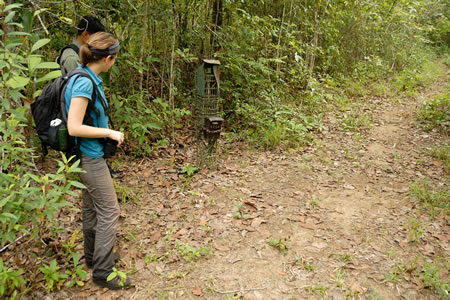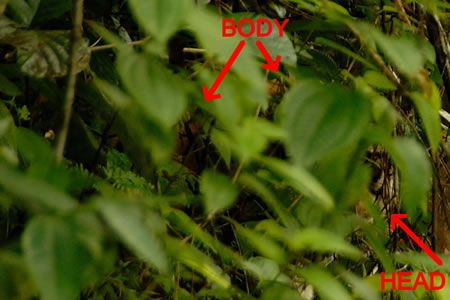

| The eye of the tiger | |
Banda Lampung (Indonesia), July 10th 2008 |
|
The Way Kambas National Park, on the southern tip of the Indonesian Island of Sumatra, is high on our wish list of Sumatran highlights. The park is especially famous for its huge and diverse bird life. It is also the park where you can see the critically endangered Storm’s Stork and White-winged Duck. Enough reasons for us to travel to this national Park. But what we did not know at that moment is that our visit to Way Kambas NP did not go as expected. It became one of our most exciting days so far of our journey. The day started early in the morning on the bus station of the city of Bandar Lampung. We are lucky today because we only have a bus ride of two and a half hours. To reach the Way Kambas NP, we first have to take a public bus to the small town of Way Jepara. The bus ride goes well, despite the very bad quality of the bus seats. In the two and a half hours of this bus ride, we get more backache than on all the Sumatran bus rides before. And that was more than eighty hours of ‘bussing’. In Way Jepara we go in search of transport to the village of Rajabasalama, ten kilometres further away. Rajabasalama is the village where you can find the main road into the national park, and it is the village where the head office of the Way Kambas NP is located. We find an ‘opelet’ (some kind of small minibus) that brings us to the head office to arrange all the necessary documents. We need for instance a letter of recommendation to get permission to enter the park. This sounds much more difficult than it is. In fact, it is quite easy to get the necessary papers. Just pay the money they ask, and all the papers will be arranged. By the way, it is funny to see how many people can be involved in processing the papers. We immediately think again: ”the cost of labour must be really cheap here if you see how many people do senseless work”. But ok, it has also its advantages. Because most people have nothing to do, they offered us to help us finding transport to the park, in particular to the ranger station Way Kanan. That’s the place we want to go, because it seems to be the best place to see a lot of birds. Edwin jumps on the back of the motor of one of the national park employees and drives to the village to look for two ‘ojeks’. An ojek is a man with a motor cycle who hires himself as taxi. So, it’s some kind of a motor-taxi. Fifteen minutes later, Edwin is back again in the office with two motor-taxis. Ivonne just finished the bureaucratic paper-thing, so we are ready to go. |
|
 |
|
Inspecting the camera trap in Way Kambas NP |
|
We both jump on the motor-taxi and zoom in the direction of the national park. Way Kambas is a typical example of an Indonesian National Park that suffered a lot from the illegal logging. Almost nothing of the initial forest is left. But for some reason, the park developed as an important safe haven for many birds. Besides birds, it is still possible to see elephants, and if you are really lucky, even rhino’s and tigers. However, sightings are extremely rare. We drive over a former logging path deep into the national park. In a little bit less than one hour we reach Way Kanan. This ranger station is nothing more that five buildings, of which one building is transformed to a simple but clean guesthouse. There is no restaurant, so you have to bring your own food or you must be content with the instant noodles that the park rangers can prepare for you. We chose for the last option, and together with the biscuits and nuts that we brought from the village, it was enough to survive. We register ourselves at the park rangers and they subsequently tell us that it is not possible (anymore) to go into the forest on our own. That is a massive disappointment. We like to stroll through the forest on our own and definitely are not interested to pay a lot of money for a useless mandatory guide (Rp 150,000 for a couple of hours). In any case, we have the feeling that the park rangers smelt the money of foreigners. Besides the huge amounts that they ask for guiding services and boat trips, they also increased the price of the rooms from Rp 75,000 to Rp 150,000 last year. Heavily disappointed, we plod back to our room to discuss what to do. We don’t like to pay more money for the park than we already did for the recommendation letter, park entrance fee, photo camera fee, transport costs and cost for the room. We simply don’t want to pay also for every step that we take outside the ranger station. |
|
 |
|
The Sumatran Tiger moving backwards into the bushes again after he noticed us |
|
Nonetheless, we decided to go on our own and to stay on the main jeep track, the track from the park entrance to the ranger station. Officially it is not allowed, but who cares is what we think. Nobody seems to be concerned about anything is this country, so why about us. We start walking and already in the first hour we see nice birds like for instance the Red-crowned Barbet and the Scarlet-rumped Trogon. After one and a half hours, we decide to take a break. We sit down on a trunk alongside the jeep track to drink some water. Within a couple of minutes we hear the sound of crisping leaves behind us in the forest. Edwin says to Ivonne: “sssjjjjt, be quiet, it is probably some kind of a pheasant that will cross the path soon”. A couple of seconds later, Ivonne whispers: “I think it is bigger …. a wild pig for instance”. The sound is now so close that we look over our left shoulder to see what kind of animal wants to cross the jeep track. Our hearts stop beating for several seconds. We are looking into the eyes of a wild tiger that is watching us from a distance of approximately 10 metres. “Shit, it’s a tiger”, is what Edwin says with an excited soprano voice. Edwin takes his photo camera as motionless as he can, to take a picture. The tiger has not the intention to be a photo model and goes backwards in the bushes while keeping an eye on us. He is probably more terrified of us, than we of him. We arise very carefully to take a better look, but with even less noise than he came, he disappears again into the forest. We decide to walk back immediately to ranger station not without looking backwards several times to see if the tiger is not behind us. But when we arrive at the ranger station to tell our exciting story, they do not seem to be very amused. Even stronger, they reprimand us for leaving the ranger station without a guide. When we ask them again if they really can’t give us permission to walk in the forest on our own, the answer is predictable. For that reason we decided to leave the park again, not after doing a short and too expensive boat trip on the next morning. After all, our visit to Way Kambas couldn’t be more exciting. © copyright - Babakoto.eu / 2008 |
|